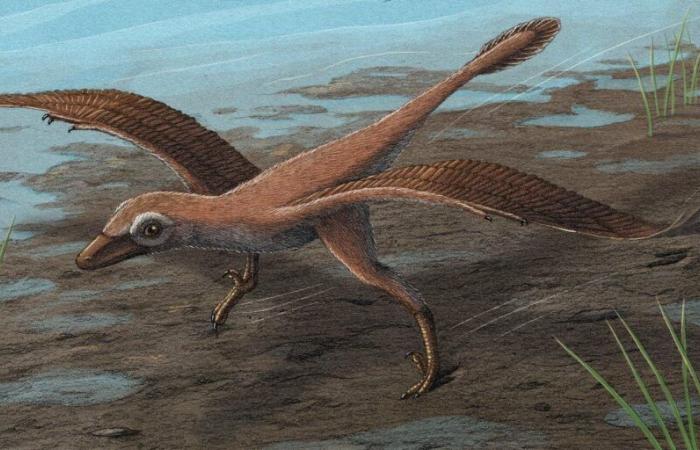A species of miniature dinosaur has paleontologists perplexed. Small footprints suggest it used its wings… to run faster, not to fly.
How was this dinosaur able to lengthen its strides in such a surprising way? An enigma that researchers explored by analyzing footprints discovered in South Korea.
The study published in Pnas thus reveals that Dromaeosauriformes are rarea raptor the size of a birdflapped its wings All while running. This behavior allowed him to achieve a vitesse unprecedented for a dinosaur no avian. The footprints show a stride three times longer than that of a ostrich. An improbable feat for a dinosaur weighing barely 20 grams, which flapped its wings to gain speed.
This “assisted run” was not intended to take off, but to run faster. An effective way to escape predators or, conversely, to surprise prey.
By reconstructing his movements, researchers estimate that he reached 37 km/h. This mode of locomotion combining running and flapping wings offers unique insight into the evolution of flight in dinosaurs. At the house of D. rarethis mechanism ofacceleration shows the ingenuity of its adaptation.
B: Map of the site faithfully illustrating the layout of the footprints and empty spaces on the ground.
CE: Distinct morphology of individual tracks from track 2 (R1, L1 and R2) confirming the microraptorine track maker.
These fossil traces prove that flight among dinosaurs did not develop in a linear fashion. New discoveries could confirm the existence of flight abilities in other non-avian dinosaurs.
What is wingbeat-assisted running?
“Wing-assisted running” refers to a mode of locomotion where a animal uses wing flaps to increase running speed. This movement, observed in certain modern dinosaurs and birds, helps to overcome obstacles or accelerate without flying away.
During assisted running, the wings produce a lifting force that lightens the animal and lengthens its strides. This mechanism, called “flap running” in English, allows the animal to reach speeds that it could not obtain with its legs alone, giving it an advantage in fleeing predators or catching prey.
In research, several clues show that the wings of some dinosaurs like Dromaeosauriformes are rare were not adapted to flight but rather served to accelerate their course:
– Wing size: Paleontologists observed that this dinosaur’s wings were too small to allow it to fly. They would therefore not have been able to generate sufficient lift force for prolonged flight.
– The distance of fossilized footprints The traces found show a very extended stride in relation to the size of the animal, which suggests a propulsion additional. This distance indicates a thrust which makes it possible to increase the length footsteps, typical of a run, with no evidence of flight.
– Le concept de “flap running” Scientists have compared this movement to modern birds flapping their wings to climb or run faster, but without taking off. By analyzing the impressions and anatomical characteristics of the wings, they concluded that this technique helped to lengthen strides, not to rise into the air.







